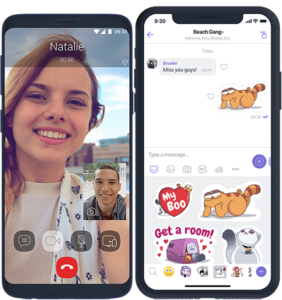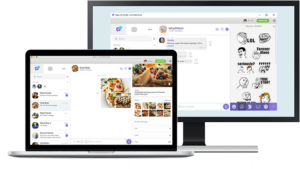Viber’s formula to measure active users
With some 260 million monthly active users, Viber messenger is the world’s number-three messaging app. Idan Dadon, Product Manager at Viber, is in charge of building a data-driven culture at the company and mentors PMs in working with the right frameworks, making the right decisions and building a product strategy that is built for growth. He speaks to us today about how to shift attention from vanity metrics to metrics that matter.
In the latest installment of our Metrics that Matter series, we’ll learn:
- How Viber defines an active user
- What retention strategies work on the very newest users
- How Viber prioritizes what to build next
What does being data-driven look like at Viber?
Being data-driven means looking beyond the vanity metrics. Before, one of the core company metrics was monthly active users. Now, we’ve created a quality stickiness metric, which deals with how our users actually behave. Our north star metric is the total number of active users–people who are using Viber seven days a week to message or communicate with peers and contacts, or to consume content through bots or communities.
We might not achieve numbers as high as the C-level wants to see, but from a product perspective, if we’re doing something good, active users will grow and if we’re doing something bad, their number will drop.
We monitor this metric carefully and prioritize our initiatives to improve it. We’ve done this across teams and it’s now tied to every employee’s bonus. I’m happy to report that we’re making great progress.
What is the one action event in your product that you really care about?
Viber is the world’s third-largest messaging app. If we’re going to grow in new markets, or to maintain our current market position in countries where we have a strong presence, new users must start a conversation. If they don’t have anyone to communicate with, then eventually they’ll just drop. For existing users, referral is what we’re aiming for.

When you say they’re active, do you mean they log in or do you mean they log in and do something?
We had intense discussion about that, because there’s a lot of value you can take from Viber’s communities–content, messaging, calls and bots and more.
Eventually, we decided to look at it in terms of the way we’re communicating value to our customers. If you’re a new user, how do you perceive Viber? It could be one of two main things: you’re using Viber for messaging or communicating with your peers and your contacts, or you’re using it for consuming content either through bots or communities.
We’ve decided to split users into two groups–the core active users and the content consumers. The core users are those who send a message or start a call. We have users who are active two out of seven days and users who are active five out of seven days. Our goal is to drive the 2/7 users (who we call adopters) to become 5/7 users (our basic users). If we’re going to become the world’s primary messaging app, we have to push everyone from 2/7 to 5/7, and hopefully get them to as much as 7/7.
What are some cohorts you/your team has created and how do you use these cohorts in your analysis?
Our cohorts include percentiles of activity (to identify power users) and region- and country-based cohorts (there’s a lot of cultural difference in how people use the app as well as their data usage). We break it down as much as we can and try to understand users based on their behavior, not the average behavior.
What are some retention strategies that have worked for you?
Retention is tough because of the network effect–if you have no contacts on the app to chat with, you’re not going to hang around very long. Imagine if your friends are using Viber, but your work friends aren’t, you won’t be able to contact them there, or maybe even friends from other circles.
In terms of the strategy, we’re trying to understand how we can get a user that is retained, try to understand what they do, and then try to get users that are not retained to form the same habits.
Once we find a habit, we try to understand how to get users that are potentially not retainable to engage in that habit– join a community or start a new conversation, for example. That’s my primary focus right now, to convince new users with no contacts to form a Viber habit so they stay long enough for their contacts to also join. If you cast your mind back to 2010-2012, messaging apps experienced exponential growth because everyone just adopted one. Today, however, 90-something percent of the world is WhatsApp.
We’re dominating in nine countries. When you need to fight for market presence and market domination, you need to retain these new users for enough time for them to discover the value in Viber.
How do you prioritize what to build next?
Simply put, we try to build the thing that will have the greatest positive impact on our north star metric–the number of active users per our definition. We’ve redesigned our prioritization methodology for understanding adoption and usage to try and understand the true value of a feature versus the value you think the user will derive. This is the value gap that PMs are really experiencing.
Bottom line: 90% of the time we’re wrong. That’s the value in the iteration process.

How (if at all) do you work with your marketing / user acquisition team?
We’ve integrated Mixpanel with our user acquisition and marketing teams. Technical collaboration completely changes how people work together. For example, customer acquisition can buy media efficiently through knowing which users come from what channels, which users are actually retained, and where those retained users are coming from.
What makes a good PM vs. a great PM?
A good PM focuses on releasing more–new ideas, new products, new features–while a great PM ensures that all those things reach their full potential.
If I had to choose one characteristic of a great PM, I’d say curiosity. If you’re not curious, you’re not seeking to understand how you can drive a better value for users. You’re not going to be data-driven. If you’re not curious about the why, all you’re doing is the what and the how.
If you’re not curious, you’re not seeking to understand how you can drive a better value for users


